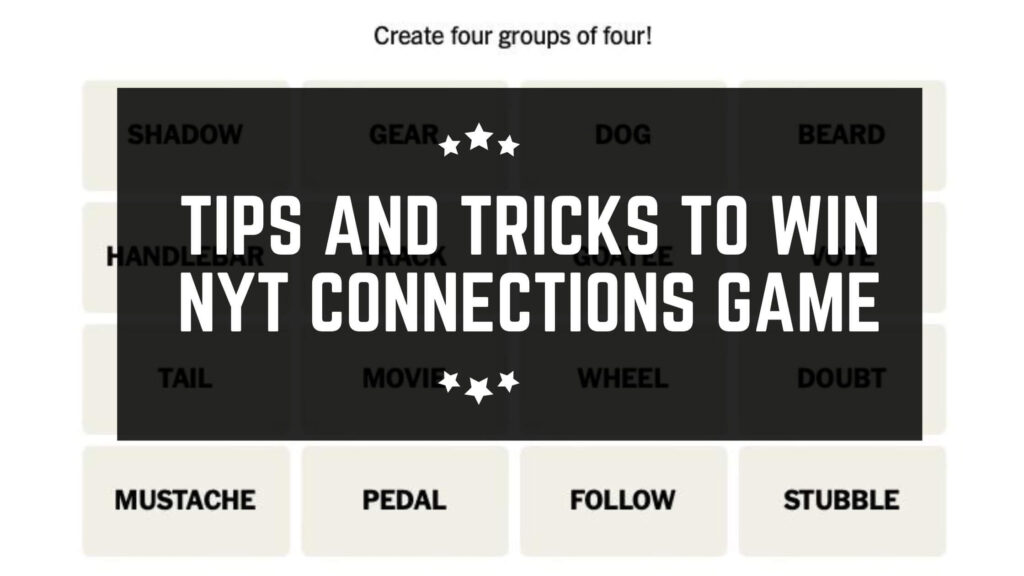
The NYT Connections game has become popular among word puzzle fans, adding a new spin to traditional word games.
Players must sort 16 words into four groups based on common themes, testing both their vocabulary and critical thinking skills.
Like any good puzzle, success in Connections takes strategy and practice.
Whether you’re experienced or just starting, using helpful tips can boost your gameplay.
From spotting synonyms to finding distinct words, here are New York Times’ Connections tips and tricks you can leverage to improve your chances of winning this exciting daily challenge.
Understand the Game Mechanics
The game presents you with a 4×4 grid of 16 words, and your objective is to identify the connections between them.
You must determine which four words belong together in each of the four categories.
The categories are not explicitly stated, so you need to infer the common thread that links the words in each group.
Once you have identified all four categories, you can submit your answer. If you are correct, you will move on to the next puzzle.
If not, you will have a limited number of attempts to try again.
Look for Parts of Speech
Start by examining each word to determine its part of speech—whether it is a noun, verb, adjective, or adverb.
This initial categorization can simplify the grouping process, as words with similar grammatical functions often share thematic connections.
For instance, if you identify several nouns, consider whether they relate to a common subject, like animals or countries.
Similarly, verbs may indicate actions that fall under a specific category, such as sports or activities.
By clustering words based on their parts of speech, you can more effectively identify potential categories and streamline your decision-making process.
Consider Synonyms
Another strategy you can usewhen analyzing the words is to think about potential synonyms or closely related terms that could form a category.
For example, words like “happy,” “joyful,” and “cheerful” might naturally group together due to their similar meanings.
However, be vigilant, as some words may appear synonymous at first glance but can lead you astray.
These misleading terms, known as red herrings, can disrupt your thought process and cause incorrect groupings.
To avoid this, take a moment to reflect on each word’s nuances and context, ensuring that your connections are based on solid semantic relationships rather than superficial similarities.
Identify Distinct Words
As you scan the words, look for terms that have a clear and distinct meaning or context.
These words are often the easiest to categorize, as their uniqueness makes them stand out from the rest.
For example, a word like “pyramid” is more distinctive than a common noun like “book.”
If a word appears to be one-of-a-kind or significantly different from the others, it can serve as an excellent starting point for building a category.
By focusing on these distinct words first, you can establish a solid foundation for your groupings and then work outward to find the remaining words that fit logically within each category.
Look for Overlaps
As you analyze the words and begin forming categories, be mindful that some terms may have the potential to fit into multiple groups.
This overlap can complicate your guessing process, as a word that seems to belong in one category could also logically fit into another.
To avoid making incorrect assumptions, carefully consider all possible connections for each word.
For instance, the word “key” could relate to a physical object, a musical note, or a solution to a problem.
Recognizing such overlaps can go a long way in helping you make more informed decisions about which categories each word belongs to, ultimately leading to a more accurate solution.
Shuffle the Board
If you find yourself stuck or unable to identify clear connections between the words, utilize the shuffle feature to rearrange them on the grid.
This simple action can significantly impact your perception of the puzzle.
By presenting the words in a different order, shuffling provides a fresh perspective that may reveal connections you previously overlooked.
Sometimes, the positioning of words can obscure their relationships, and rearranging them can help you spot patterns more easily.
Additionally, shuffling can break up any preconceived notions you may have formed about the words, allowing you to approach the puzzle with a more open and unbiased mindset.
Avoid Premature Guesses
Resist the temptation to make guesses too early in the game.
While it may be tempting to start categorizing words as soon as you see them, it’s crucial to gather as much information as possible before committing to a solution.
Making guesses prematurely can lead to mistakes that limit your remaining attempts.
Take the time to carefully analyze the words, identify potential connections, and explore different possibilities before finalizing your categories.
Practice Trivia
Engaging with a wide range of trivias can significantly enhance your performance in the Connections game, as many word associations rely on general knowledge across diverse topics.
To prepare, explore various trivia categories such as history, geography, pop culture, science, and literature.
Regularly quizzing yourself or participating in trivia games can help reinforce your knowledge and improve recall.
Additionally, consider using trivia apps or websites that offer quizzes on different subjects.
The more familiar you become with a wide range of terms and concepts, the easier it will be to identify connections and group words effectively during gameplay.
Stay Calm and Have Fun
It’s essential to approach the Connections game with a relaxed mindset.
Remember, the primary goal is to enjoy the challenge, not to achieve perfection.
Embrace the learning experience, and view mistakes as opportunities for growth rather than setbacks.
If you find yourself feeling frustrated, take a break and return with a fresh perspective.
Each puzzle is a new chance to improve your skills, and there will always be another puzzle tomorrow, so savor the journey!
